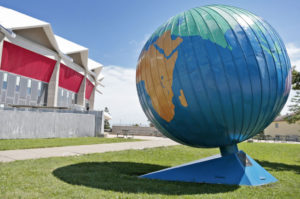
The Earth, represented here by a globe on display at the Wisconsin Dairy Expo, wobbles on its axis every 27,000 years. (Photo credit: State Journal Archives)
The Earth revolves around an imaginary line that passes through the North and South Poles, known as the spin axis. As it spins the Earth drifts and wobbles. And now scientists have identified three reasons.
The Earth wobbles on its axis once every 27,000 years, similar to a spinning top. This alters the relationship between the solstices and the distance from the Earth to the Sun. For example, 11,000 years ago the Northern Hemisphere summer solstice occurred at perihelion, when the Earth is closest to the Sun. That is almost the exact opposite of the case today,
This “synching up” of summertime with perihelion made the differences between winter and summer more pronounced 11,000 years ago than they are today.
More generally, the solstices and equinoxes move slowly forward through the calendar with each passing year, a phenomenon known as precession.
Earth’s spin axis also drifts. Measurements indicate the spin axis drifts by about 4 inches per year, or more than 11 yards over a century.
Earth isn’t a perfectly round spinning object. There are three processes that redistribute mass that cause the spin axis to move:
- Changes in Earth’s mantle caused by convection in Earth’s interior;
- Mass loss due to melting of ice (mostly on Greenland); and
- Uplift of land that was once buried under glaciers.
The melting of Greenland glaciers into the oceans has redistributed mass resulting in the spin axis drift.
That melting along with Greenland’s location makes it a significant contributor to polar motion.
Greenland’s ice mass has decreased by a weight that is larger than 20 million Empire State Buildings.

